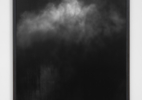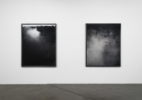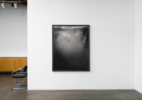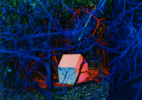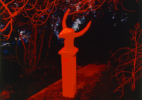Gallery Luisotti is pleased to announce the upcoming exhibition, John Divola: Physical Evidence. Divola, whose series Abandoned Paintings (2007-08) was featured in the 2017 Whitney Biennial, is known for his visual exploration of abandonment and ruin in the Southern California landscape, and often with a sense of humor bordering on pathos. Physical Evidence will feature two bodies of work, Untitled 1990 (1990) and the Five Prints Portfolio (1987), that may (at first) seem distant from the concerns of his more recent work. However, these two rarely exhibited bodies of work show Divola’s long held commitment to exploring the contradictions of a medium caught between document and artifice.
Divola’s black-and-white works in the series Untitled 1990 read like a Whistler Nocturne painting: the subject matter is elusive while the monochromatic surface captivates with an ethereal sense of space. In 1990, Divola stated that the works
… are all large, unaltered, black and white photographs. They are photographs of handfuls of flour thrown at painted backdrops. The backdrops are rather sloppily, and expressionistically, painted.
Clouds, the cosmos, and atmosphere, make up a vocabulary of the sublime, the universal. The means involved here (throwing flour at shamelessly expressionistic backdrops) are pathetic and obvious. The vehicle (the photograph) is industrial, mute, and dead.
As with his Abandoned Paintings or his early series Vandalism, there is an aspect of Untitled 1990 that is performative, while also deeply engaged in photography’s relationship to the history of painting. Yet the work’s rigorous conceptualism is counterbalanced with Divola’s wry humor: a gestural tossing of flouring akin to Baldessari’s Throwing Three Balls in the Air to Get a Straight Line (1973). That said, the performance itself eludes the document, and the image we are left with endures as a sublime painterly field.
On its back wall, the gallery will feature Divola’s Five Prints Portfolio. The prints feature site-specific constructions made by Divola, set within dense underbrush. More iconographic than Untitled 1990, they are nonetheless imbued with a similar evasion of photography’s indexical qualities. The event captured – be it a howling wolf or a spinning cyclone or a ‘flying’ man – exist only for the photographic impression. With their artifice played up through vibrant, theatrical lighting and a subversion of natural scale, they lead the viewer to question the very conditions under which the photographs were made, a concern which haunts all photographic imagery.





